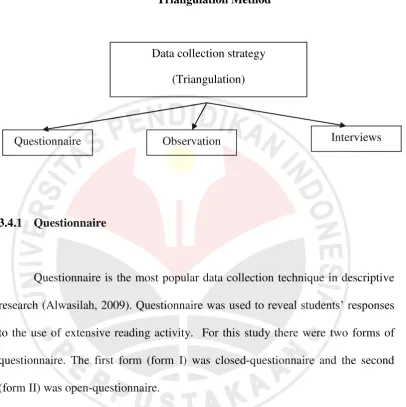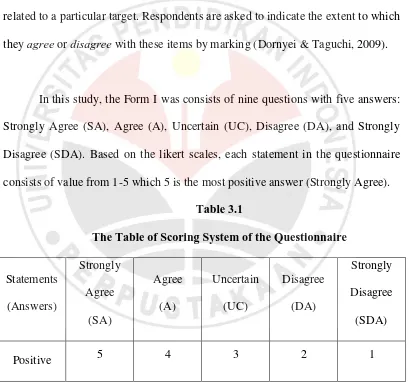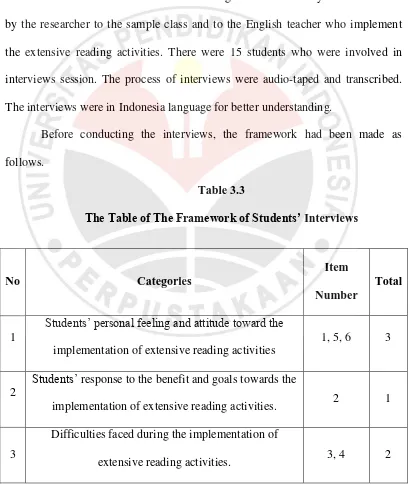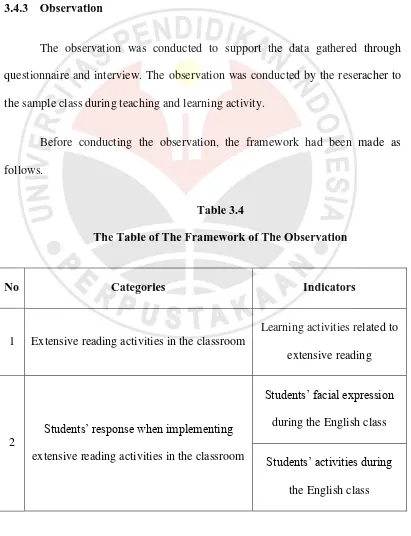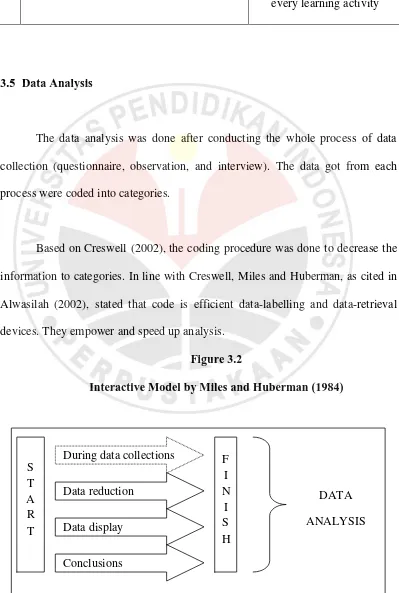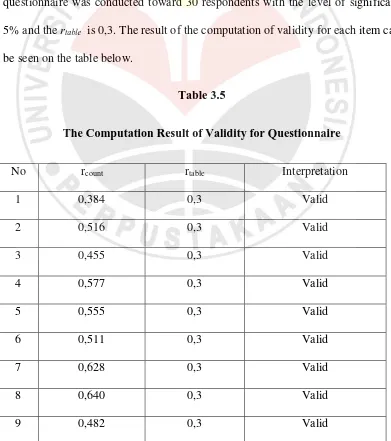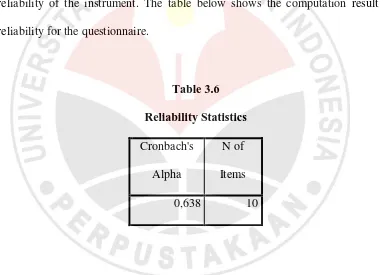LIST OF CONTENTS
STATEMENT OF AUTHORIZATION ... Error! Bookmark not defined. PREFACE ... Error! Bookmark not defined. ACKNOWLEDGEMENT ... Error! Bookmark not defined. ABSTRACT ... Error! Bookmark not defined.
LIST OF CONTENTS ... i
LIST OF FIGURES ... ivx
LIST OF TABLES ... x
LIST OF APPENDIXES ... xi
CHAPTER I: INTRODUCTION ... 1
1.1 Background of the Study ... 1
1. 2 Research Questions ... 3
1. 3 Aim of the Study ... 3
1. 4 Reasons for Choosing the topic ... 4
1. 5 Significance of the Study ... 4
1. 6 Scope of the Study ... 5
1. 7 Research Method ... 5
1. 7.1 Research Design ... 5
1. 7.2 Population and Sample ... 6
1. 7.3 Data Collection ... 6
1. 7.4 Data Analysis ... 7
1. 8 Organization of the Paper ... 9
CHAPTER II: REVIEW OF RELATED LITERATURE ... 11
2.1 Extensive Reading Activity: Definition and Characteristics ... 11
2.3 Extensive Reading Activity: Kinds of Activities ... 16
2.4 Teaching Vocabulary ... 17
2.5 Principles of Teaching and Learning Vocabulary ... 19
2.6 The Relationship between Teaching Extensive Reading and Teaching Vocabulary ... 20
2.7 Previous Studies relates to the Implementation of Extensive Reading Activities in Learning Vocabulary ... 20
CHAPTER III: RESEARCH METHODOLOGY ... 22
3.1 Research Question ... 22
3.2 Research Design ... 22
3.3 Research Subject ... 23
3.3.1 Population and Sample ... 23
3.4 Data Collection ... 23
3.4.1 Questionnaire ... 24
3.4.2 Interviews ... 27
3.4.3 Observation ... 28
3.5 Data Analysis ... 29
3.5.1 Quantitative Data ... 30
3.5.2 Qualitative Data ... 34
3.6 Establishment of Trustworthiness ... 34
CHAPTER IV: FINDINGS AND DISCUSSION ... 36
4.1 Findings ... 36
4.1.1 Students’ Responses to the Use of Extensive Reading Activities in Leaning New Vocabulary... 36
4.1.1.1 Affective Response ... 36
4.1.1.2 Purpose-Driven Response ... 41
4.2 Discussion ... 49
CHAPTER V: CONCLUSIONS AND SUGGESTIONS ... 53
5.1 Conclusions ... 53
5.2 Suggestions ... 55
5.2.1 For Teachers who are Interested in the Implementation of Extensive Reading Activities ... 55
5.2.2 For the Next Further Study ... 56
LIST OF FIGURES
CHAPTER III
Figure 3.1 : Triangulation Method Figure
Figure 3.2 : Interactive Model by Miles and Huberman (1984) CHAPTER IV
Figure 4.1 : Students’ Feeling whether Assignment to Read at Home or outside the Class is a Joyful Activity
Figure 4.2 : Students’ Response whether They are Happy in Participating in a Class or Group Discussion Related to the Text They have Read outside the Class
Figure 4.3 : Students’ Response whether Extensive Reading Activity Motivates Students in Learning New Vocabulary.
Figure 4.4 : Students’ Response whether Extensive Reading Activity Help Students to Learn New Vocabulary
Figure 4.5 : Students' Response whether Assignment to Read at Home/outside the Class is a Beneficial Activity
LIST OF TABLES
CHAPTER III
Table 3.1 : The Table of Scoring System of the Questionnaire. Table 3.2 : The Table of The Framework of Students’ Questionnaire Table 3.3 : The Table of The Framework of Students’ Interviews Table 3.4 : The Table of The Framework of The Observation Table 3.5 : The Computation Result of Validity for Questionnaire Table 3.6 : Reliability Statistics
Table 3.7 : Percentage Classification CHAPTER IV
LIST OF APPENDIXES
Appendix 1 : Official Letters Appendix 2 : Research Instruments Appendix 3 : Data Collection Appendix 4 : Lesson Plan
Chapter I
INTRODUCTION
This chapter introduces the nature of the study. In detail, this chapter consists of the background of the study, research questions, aims of the study, reasons for choosing the topic, significance of the study, scope of the study, research method, and organization of the paper.
1.1 Background of the Study
Vocabulary mastery is very important in language learning. According to Cameron (2001), the foundation to learn foreign language is by building up useful vocabulary. Many people realize that their vocabulary is limited so that they have difficulties in expressing their idea. Therefore, vocabulary mastery of a language is important in order to convey ideas.
According to Wilkins (1972) as cited in Chen (2009), someone can convey a little if they do not understand grammar, but they cannot convey anything without vocabulary. Another supporting statement is that fluent speakers and writers put together parts of language system quickly and efficiently (Pinter, 2006). In order to gain this skill, people need to master vocabulary and grammatical structures. It is the reason why vocabulary is central to language and vocabulary is important as the basic need in learning a new language.
podcasts from the internet, students can learn new vocabulary. Another way to teach vocabulary is through reading. Students can read many things from many sources to add to their vocabulary bank.
According to Harmer (2007), there are two kinds of reading activity. There are intensive reading activites and extensive reading activities. The term intensive reading activity means students read their reading text in a classroom. On the otherhand, the term extensive reading activity refers to the reading activity which is done out of the classroom (Harmer, 2007). Extensive reading is also called joyful reading because students have a chance to choose reading text based on their choice. By choosing reading texts of their own preference, the students may be intrinsically motivated to perform classroom tasks. This condition may also motivate the teacher to perform a learning activity (Brown, 2001). Thus, it is believed that extensive reading can enhance students’ motivation to read and make them easily learn new vocabulary.
There are two similar research related to extensive reading activities. The researches were conducted by Rosszell (2006) and by Day (2004). Rosszell (2006) conducted a research which found that in learning new vocabulary, extensive reading activities is more effective than using direct vocabulary instruction.
students can find many new unfamiliar vocabulary and learn it as part of their reading activity.
Considering the benefit of extensive reading activities in learning new vocabulary, this study intends to investigate students’ responses to the use of extensive reading activities in learning new vocabulary. Therefore this study is entitled “Students’ Responses to The Use of Extensive Reading Activities in Learning New Vocabulary”.
1.2 Research Questions
Based on the research purposes, the researcher formulates the research questions as follows:
1. What are students’ responses to the use of extensive reading activities in learning new vocabulary?
2. What difficulties are faced by the students in implementing extensive reading activity in learning new vocabulary?
1.3 Aim of the Study
Based on the questions formulated above, the objectives of the study are presented as follow:
1. To investigate students’ responses to the use of extensive reading activities in learning new vocabulary.
1.4 Reasons for Choosing the Topic
To be able to communicate in a language, students have to acquire vocabulary, and reading is very useful for language acquisition; reading also has a positive effect on students’ vocabulary knowledge, on their spelling and on their
writing (Harmer, 2007). Therefore, extensive reading as one of activity related to reading is chosen to teach vocabulary.
Extensive reading activity is implemented outside the class and the reading material is chosen by students. Self selection of reading materials by the students will make them enjoy their reading in their spare time and variety of reading materials with various topics are available (Day & Bamford, 2004). Since self selection of reading materials will make the students enjoy their reading, this activity may be useful as a strategy in teaching new vocabulary through extensive reading in EFL classroom.
1.5 Significance of the Study
1.6 Scope of the Study
The study will be focused on investigating students’ responses to the use of extensive reading activities in learning new vocabulary. This study is expected to give information for other educators who are going to use extensive reading activities in their teaching learning activity.
This research is also dedicated to other researchers who are interested in conducting further research related to this field of study. Hopefully, this study can provide new knowledge as an alternative activity in teaching and learning process in the school.
1.7 Research Method
1.7.1 Research Design
Qualitative descriptive research will be conducted in this study. It deals with a single phenomenon of interest and state this phenomenon in a purpose statement.
1.7.2 Population and Sample
This study will investigate the 12th grade students of one state senior high school in Banten Province. They are chosen as recommendation from the school.
1.7.3 Data Collection
The data will be collected through the following instruments:
a. Questionnaire
The use of questionnaire as the instrument in this study is to reveal the students’ responses to the use of extensive reading activities in learning new
vocabulary and also to investigate problem faced by the students when dealing with extensive reading activities.
b. Interview
The interview will be conducted to support the data collected from questionnaire. In addition, the interview is expected to check the accuracy of the questionnaire and find some additional information.
c. Observation
Observation will be conducted to check the students condition when class discussion is conducted as one of extensive reading activity. Observation will be heald by the researcher while the English teacher is teaching the English subject.
1.7.4 Data Analysis
There are two kinds of data to be analyzed. Those are qualitative and quantitative data. Descriptive analysis will be used to analyse the qualitative data in order to describe and clarify the data.The calculation of percentage technique will be used to organize the quantitative data. There are three ways to comprise the data.
1. Calculating the frequency (fo) of the respondents who answer the questionnaire items.
2. Calculating the percentage of each total frequency of the respondents’ answers to the item by using the formula below:
� = ��
× 100 % �
Where:
P = Percentage of each category
Fo = Frequency of answer.
1.8 Organization of The Paper
CHAPTER I INTRODUCTION
This chapter will present Backround of the Study, Research Questions, Aim of The Study, Reasons for Choosing The Topic, Significance of The Study, Scope of The Study, Research Method (Research Design, Population and Sample, Data Collection, Data Analysis), and Organization of The Paper
CHAPTER II REVIEW OF RELATED LITERATURE
In this chapter, some theories related to students’ responses to the use of extensive reading activities in learning new vocabulary will be discussed. The aim of review of related literature is to match both theories and fact that will be gained from the study.
CHAPTER III RESEARCH METHODOLOGY
In this chapter, there will be a discussion about the process of investigation. Moreover, this chapter presents the research methodology which deals with research design, research subject, procedure in collecting the data and data analysis.
CHAPTER IV FINDINGS AND DISCUSSION
CHAPTER V CONCLUSIONS AND SUGGESTIONS
Chapter III
RESEARCH METHODOLOGY
This chapter will present the research methodology which will deal with research questions, research design, research subject, data colletion, data analysis and establishment of trustworthiness.
3.1 Research Questions
Research questions on this study are formulated as follows:
1. What are students’ responses to the use of extensive reading activities in learning new vocabulary?
2. What difficulties are faced by the students in implementing extensive reading activities in learning new vocabulary?
3.2 Research Design
According to Nazir (2003), descriptive method is a method which analyzes the status of a group, an object, a set of confition, or an event happening in the present. It means descriptive method is aimed to describe the current situtaion.
3.3 Research Subject
3.3.1 Population and Sample
The selection of the school was based on the following consideration. The school considered that students’ vocabulary mastery should be improved, so the school gave a chance to the researcher to conduct a research.
The population of this study was the twelve grade students of a senior high school in Banten. The sample of this research was XII Social 3 class. The total number of the class was 30 students. In choosing the sample, this particular class was chosen based on the recommendation from the school
3.4 Data Collection
In collecting the data, triangulation technique was used. Based on Alwasilah (2009), in qualitative research, triangulation technique is a technique to collect data from some sources. Triangulation technique was used to make sure all the data gained relatively consistent.
Figure 3.1
Triangulation Method
3.4.1 Questionnaire
Questionnaire is the most popular data collection technique in descriptive research (Alwasilah, 2009). Questionnaire was used to reveal students’ responses to the use of extensive reading activity. For this study there were two forms of questionnaire. The first form (form I) was closed-questionnaire and the second (form II) was open-questionnaire.
Form I was closed-questionnaire. In this questionnaire, respondents were provided with ready-made response options to choose from, normally by ticking
or encircling one of them by putting an “X” or “V” in the appropriate slot or box
(Dornyei & Taguchi, 2009). So, in this closed-questionnaire, respondents were not required to produce any free writing; instead, they only choose one of the given alternatives. The benefit of this technique is that the coding and tabulation is
Data collection strategy (Triangulation)
straightforward and leaves no room for other subjectivity (Dornyei & Taguchi, 2009).
The technique in giving score towards students’ answer in this
closed-questionnaire was using Likert Scales. This scaling technique was invented by Rensis Likert. Likert scales consist of a series of statements all of which are related to a particular target. Respondents are asked to indicate the extent to which they agree or disagree with these items by marking (Dornyei & Taguchi, 2009).
In this study, the Form I was consists of nine questions with five answers: Strongly Agree (SA), Agree (A), Uncertain (UC), Disagree (DA), and Strongly Disagree (SDA). Based on the likert scales, each statement in the questionnaire consists of value from 1-5 which 5 is the most positive answer (Strongly Agree).
Table 3.1
The Table of Scoring System of the Questionnaire
Statements (Answers) Strongly Agree (SA) Agree (A) Uncertain (UC) Disagree (DA) Strongly Disagree (SDA)
Positive 5 4 3 2 1
Table 3.2
The Table of The Framework of Students’ Questionnaire
NO Categories Item
Number
Total
I Students’ personal feeling and attitude toward the implementation of extensive reading activities
1,3,4,5 3
II Students’ response to the benefit and goals towards the implementation of extensive reading activities
2, 6-9 5
Form II of the questionnaire was an open-questionnaire. Based on Dornyei and Taguchi (2009) in their book etitled “Questionnaires in Second Language Research Construction Administration and Processing”, open-ended questionnaire includes items where the actual question is not followed by response options for respondents to choose from but rather by some blank space for respondents to fill.
3.4.2 Interviews
The interviews were conducted to support the data collected from questionnaire. In addition, the interview were expected to check the accuracy of the questionnaire and to find some additional information.
The interviews were conducted in August 3rd 2012. They were conducted by the researcher to the sample class and to the English teacher who implement the extensive reading activities. There were 15 students who were involved in interviews session. The process of interviews were audio-taped and transcribed. The interviews were in Indonesia language for better understanding.
Before conducting the interviews, the framework had been made as follows.
Table 3.3
The Table of The Framework of Students’ Interviews
No Categories
Item
Number
Total
1
Students’ personal feeling and attitude toward the
implementation of extensive reading activities
1, 5, 6 3
2
Students’ response to the benefit and goals towards the
implementation of extensive reading activities. 2 1
3
Difficulties faced during the implementation of
4 Suggestion for the implementation of extensive reading 7 1
The interviews were consisted of seven questions. The data gathered were used to support the data from quesionnaire.
3.4.3 Observation
The observation was conducted to support the data gathered through questionnaire and interview. The observation was conducted by the reseracher to the sample class during teaching and learning activity.
Before conducting the observation, the framework had been made as follows.
Table 3.4
The Table of The Framework of The Observation
No Categories Indicators
1 Extensive reading activities in the classroom
Learning activities related to extensive reading
2
Students’ response when implementing
extensive reading activities in the classroom
Students’ facial expression
during the English class
Students’ activities during
Student’s involvement in
every learning activity
3.5 Data Analysis
The data analysis was done after conducting the whole process of data collection (questionnaire, observation, and interview). The data got from each process were coded into categories.
Based on Creswell (2002), the coding procedure was done to decrease the information to categories. In line with Creswell, Miles and Huberman, as cited in Alwasilah (2002), stated that code is efficient data-labelling and data-retrieval devices. They empower and speed up analysis.
Figure 3.2
Interactive Model by Miles and Huberman (1984)
S T A R T
During data collections
Based on the model, it can be seen that this study used descriptive qualitative method to analyze the data, after the data collected from questionnaire, observation, and interview were summarized. Then the items needed for the research were chosen while the unimportant ones were deleted. The deletion process is called data reduction. Then, the next step was displaying the data by using charts, tables and narrative text. In the process of displaying the data, researcher used qualitative and quasi-statistics method. From quasi-statistics, researcher could see the frequency of the appearance of each students’ responses, the qualitative method was used to explain the result from quasi-statistics method.
3.5.1 Quantitative Data
In quantitative data, the questionnaire that has been made has to go through the validity and reliability test. Both of them were important in research since if they were not recognized, it would be fatal in giving conclusion or giving reasons of the relationship between the variable (Nazir,2003). Based on Lynn and Gronlund (1995), validity refers to the adequacy and appropriateness of the interpretations made from assessment; thus validity concerns with the specific use of assessment results and the soundness of the interpretation of those result. Reliability refers to the consistency of assessment result. Reliability is needed to get the valid result.
the statements in the questionnaire were valid and reliable before conducted the questionnaire to the sample. To calculate the validity and reliability of a questionnaire with likert scale, the result of the questionnaire was calculated by Alpha-formula (Ghozali, 2001). To calculate the result, SPSS 20 for Windows 7 program was used. There were ten questions on the questionnaire. The score of validity for each item is rcount which can be seen from the corrected item-total
correlation table from SPSS data output. Each item is valid if rcount > rtable . The
questionnaire was conducted toward 30 respondents with the level of significant 5% and the rtable is 0,3. The result of the computation of validity for each item can
be seen on the table below.
Table 3.5
The Computation Result of Validity for Questionnaire
No rcount rtable Interpretation
1 0,384 0,3 Valid
2 0,516 0,3 Valid
3 0,455 0,3 Valid
4 0,577 0,3 Valid
5 0,555 0,3 Valid
6 0,511 0,3 Valid
7 0,628 0,3 Valid
8 0,640 0,3 Valid
10 0,08 0,3 Not Valid
The result of computation showed there was one question which was not
valid since it’s rcount < rtable . Thus, there were only 9 questions used.
Moreover, the calculation of Alpha Cronbach can also used to analyze the reliability of the instrument. The table below shows the computation result of reliability for the questionnaire.
Table 3.6
Reliability Statistics
Cronbach's Alpha
N of Items
0,638 10
Mursalim (2012) stated that a research instrument is stated having a high
reliability if the coefficient of Alpha Cronbach ≥ 0,6. From the table, the
coefficient of Alpha Cronbach is 0,638 which is higher than 0,6 (0,638 ≥ 0,6). So,
After the validity and reliability testing were finished, the data gathered from the questionnaire were tabulated and presented through some stages as follow:
1. Examining the data obtained from the questionnaire.
2. Calculating the frequency (fo) of the respondents who answer each of items or statements. Then, it is calculating the percentage (%) of each total
frequency of the respondents’ answers to the item by using the formula
below:
Percentage (%) = � � � � � � � ( )
� � � ( ) x 100 %
(sudajana, 1984:49)
3. Interpreting the result of percentage (%) calculation based on the total frequency (fo) of each item.
4. Classifying the data to be interpreted, therefore it is using reference according to suryadi (1987) as cited in Hamidah (2005) as follows:
Table 3.7
Percentage Classification
No Percentage Classification
1
00,00 % None
2
3
25,00 – 49,99 % Nearly half of
4
50 % Half of
5
50,01 – 74,99 % Best part of
6
75 – 99,99 % Nearly all of
7
100 % All of
3.5.2 Qualiative Data
The result of interview, observation, and open-questionnaire are included into qualitative data. Those three data collecting method were done to get more information related to the research questions.
3.6 Establishment of Trustworthiness
To reach the credibility aspect, this study applied multimethod technique to gain data. It is called triangulation technique. They are through questionnaire, interview, observation and document analysis. If they are combined, they could increase the credibility of the research. To reach the transferability aspect, it was done through thick description that enables the researcher interested in making a transfer to reach a conclusion.
Chapter V
CONCLUSIONS AND SUGGESTIONS
This chapter presents the conclusion and suggestions based on the findings of the research. The conclusion of the research is a judgement based on the process of interpreting and discussing the findings of the research.
5.1Conclusions
The implementation of extensive reading activity in learning new vocabulary got positive responses from the students. There are two types of positive responses given by the students, those responses are: affective response and purpose-driven response. Both affective and purpose-driven responses showed positive results from the students.
The affective response shows that most of the students enjoyed to do extensive reading activities and most of them stated that the use of extensive reading activities has given positive impact on their learning, especially when learning new vocabulary. The findings from questionnaire, interviews and observations stated that students gave positive response to the implementation of extensive reading activities. Most of them agreed that extensive reading activities were interesting activities, and they felt happy to do the activities.
In general the students who are driven by the purpose of learning new vocabulary have positive response. By implementing extensive reading, students have reached their purpose in improving their vocabulary mastery. Besides improving vocabulary, extensive reading activities also helped students to understand the material deeper since they have alredy read the reading material
before they were attending the class. This one influnced students’ confidence in
the class room. They felt more confidenct when they thought that they were ready to attend the class.
Although most of the students gave positive response, in implementing extensive reading, the students still encountered some difficulties such as difficulties which are categorised into three types of difficulties. The first type is knowledge-related difficulties where students encountered difficulties in translating new vocabulary founded in the text, and difficulty in chosing the appropriate word from various meanings available in the dictioanary. Then the next type is personal difficulties when students are getting lazy to read because reading is not their hobby and when the students have difficulties in time management. The last type is text-related difficulties; when the students think that the text is not appropriate enough for their age, so they feel bored when trying to read the text.
5.2Suggestions
After having the findings and discussion of the research, there are some suggestions for teachers who are interested in implementing extensive reading activities in learning new vocabulary based on students’ responses and for the next related research as recommendation.
5.2.1 For Teachers who are Interested in the Implementation of Extensive Reading Activities
a. Teachers who are interested in the implementation of extensive reeading activities in learning new vocabulary should know the concept of extensive reading before implementing it as teaching learning activity. b. Before assigning students to read the text outside the class, teachers should
give clear information about the objectives or the learning targets of the subject, therefore students know the aim of the learning activities and the reasons why they are assigned to read outside the class.
c. Before assigning the students to read the text, teachers should give clear instruction about what the students have to do, so they will not be confused about their assignment.
e. Teachers should ask the students not only to understand the content of the text, but also to find the meaning of difficult words including it’s categories/synonym/antonym and it’s example.
f. In classroom discussion, teachers should give students opportunity to ask
many things about students’s difficulties related to the reading text.
Teachers also should give students opportunity to explain their opinion about the content of the text (or about the appropriate meaning of a vocabulary).
g. To implement extensive reading activity in a big class (containing more than 20 students), teacher should divide students into group, so all students can be facilitated to convey their opinion to their group.
h. Teacher should apply various kinds of learning activities in the classroom
to make the learning process more enjoyable in order to avoid students’
boredom. It can be through presentation, discussion, debate, or games.
5.2.2 For the Next Further Study
For other researchers who are eager to investigate more about the implementation of extensive reading, the next research can consider the following suggestions:
a. The research investigates the implementation of extensive reading in different area, such as young learners.
REFERENCES
Alwasilah, Chaedar. (2009). Pokoknya Kualitatif. Pustaka Jaya.
Benettayeb, Assia.(2010) Revue Academique des Etudes Sociales et Humaines. Extensive Reading and Vocabulary Teaching. PP 20-30.
Best, J.W. & J.V. Kahn. (1989). Research in Education; 6Ed. Englewood Cliffs: Prentice Hall
Brown, H. Douglas. (2001). Teaching by Principles. An Interactive Approach to Language Pedagogy, (second edition). USA: Addison Wesley
Longman, Inc.
Chen, Yanking. (2009). English Language Teaching. A Cognitive Linguistic Approach to ClassroomEnglish Vocabulary Instruction for EFL Learners in Mainland China, 2, 95-100
Creswell, J. (2002). In J Creswell, Educational research. Analyzing and Interpreting Qualitative Data (pp256-283). Thousand Oaks: Sage
Cameron, Lynne. (2001). Teaching Languages to Young Learners. Cambridge: Cambridge University Press.
Day, R. R.,& Bamford,J. (2004). Extensive Reading Activities for Teaching Language. Cambridge: Cambridge University Press.
Day, R.R.,& Bamford, J. (2002). Top Ten Principles for Teaching Extensive Reading. Reading in a Foreign Language, 14(2) [Online]. Available at: http:// nflrc.hawaii.edu/rfl/October2002/day/day.tml
Djamruh,Hamidah.(2005) The Use of Collaboration in Teaching Writing: A Qualitative Study to 2nd Grade Students of SMAN 3 Cimahi. Bandung: Unpublished.
Dorenyei, Zoltan, & Taguchi, Tatsuya. (2009).Questionnaires in Second Language Research: Construction,Administration, and Processing. Oxon: Routledge.
Ghozali, Imam. (2001). Analisi Multivariate dengan Program SPSS. Semarang: Badan Penerbit Universitas Diponegoro.
Linn, R. L., & Gronlund, N. E. (1995). Measurement and Assessing in teaching (7th ed.). New Jersey: Prentice-Hall Inc.
Morgan, John. & Rinvolucri, Mario. Vocabulary. Oxford: Oxford University Press.
Mursalim.(2012). Pelatihan Validitas dan Reliabilitas.Malang: Unpublished. Nazir, Moh. Phd. (2003). Metode Penelitian. Jakarta: Ghalia Indonesia.
Pinter, Annamaria. (2006). Teaching Young Language Learners. Oxford: Oxford University Press.
Pearson,D. & Duke,N. (2002). Research-Based Reading Comprehension Instruction Focus on Reading. [Online]. Available at:
http://www.perfectionlearning.com/images/products/pdfs/fors/fors.whit epaper.pdf. (5 July 2012)
Pigada, Maria & Schmitt, Norbert, (2006). Reading in a Foreign Language : Vocabulary Acquisiion from Extensive Reading : A Case Study. Volume 18.
Prihartanti, P. (2008). Teacher’s Speech Modificationd in an EFL Context. English Education Department, UPI: Unpublished Paper.
Safitri, Rahmi. (2010). Students’ Perception on The Use of Portofolio Assignment in Teaching English for Young Learners Subject. English Education Department, UPI: Unpublished Paper.
Rosszell, R. (2006). The Role of Extensive Reading in Second Language Vocabulary Acquisition. In K. Bradford-Watts, C. Ikeguchi, & M. Swanson (Eds.) JALT2005 Conference Proceedings. Tokyo: JALT : 394-407
Sheu, Samuel. (2003). Tesl Reporter 36(2). Extensive reading with EFL Learners at beginning Level. PP 8-26. Page 23.
Sheu, Samuel. (2003). Tesl Reporter 36(2). Extensive reading with EFL Learners at beginning Level PP 8-26, Page 8.
Sugiyono. (2012). Metode Penelitian Kuantitatif Kualitatif dan R&D. Bandung: Alfabeta


